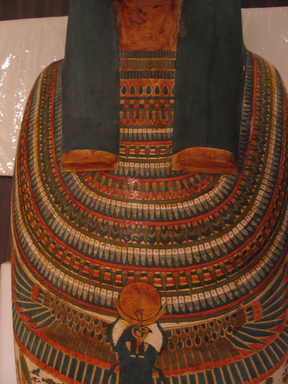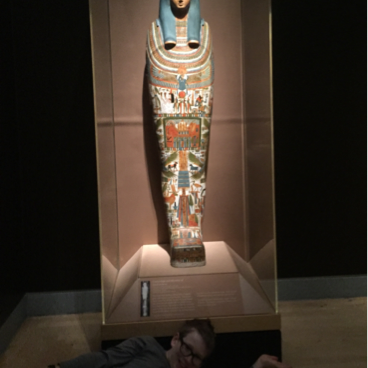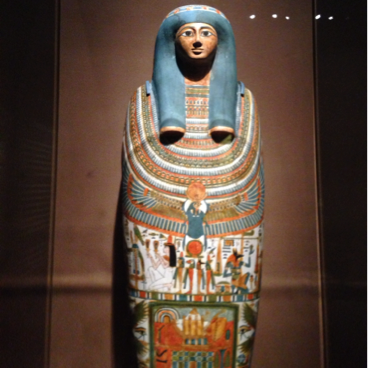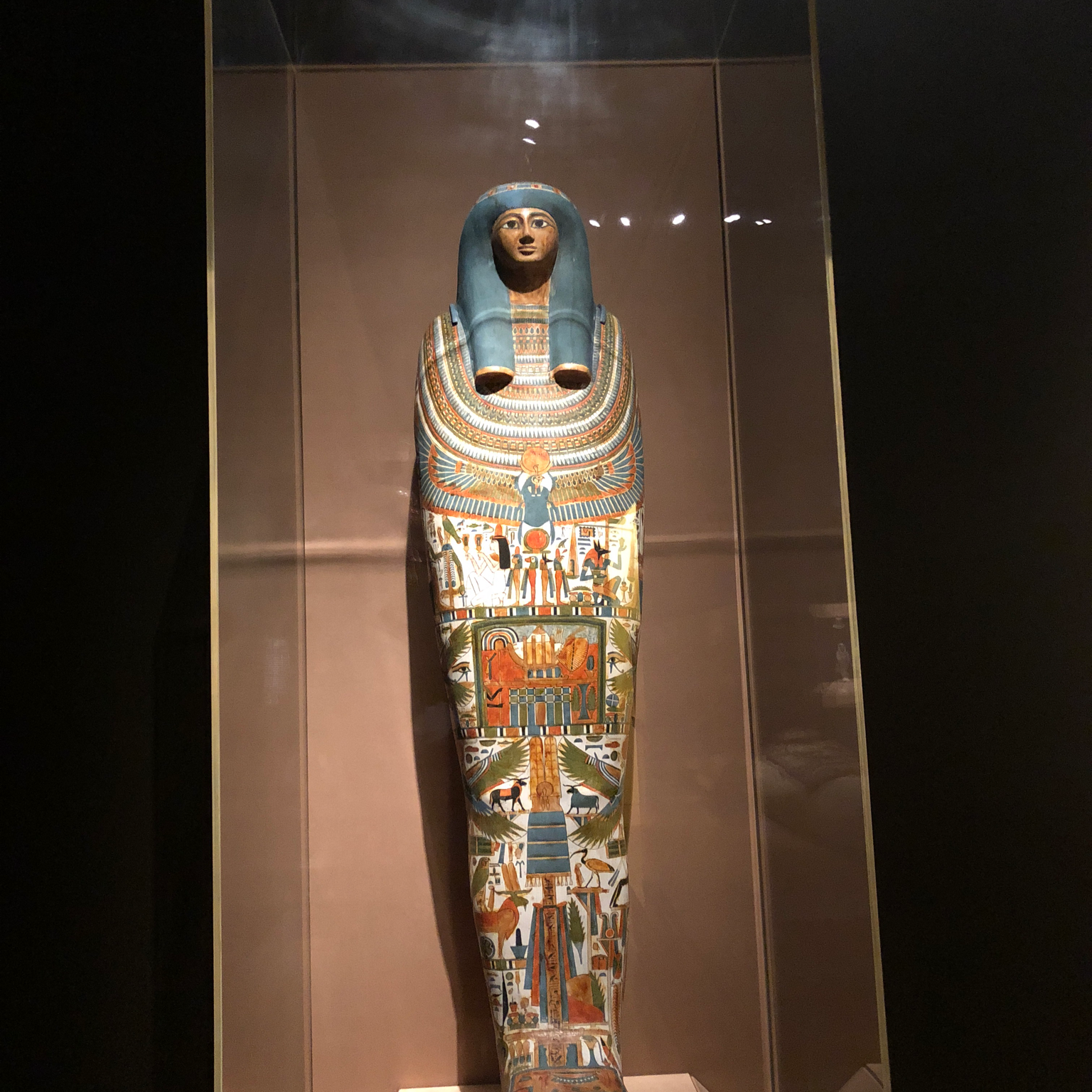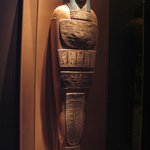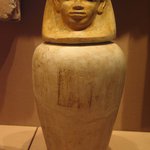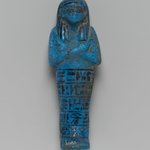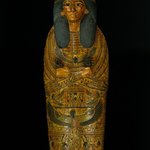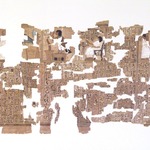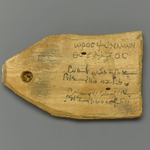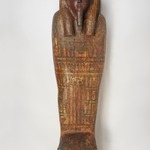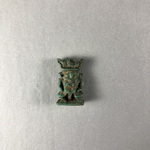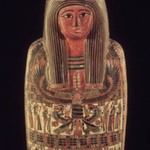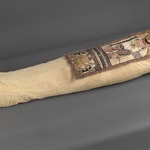

Egyptian. Inner Cartonnage of Gautseshenu, ca. 700–650 B.C.E. Linen, plaster, pigment, human remains, 65 1/4 x 16 1/2 x 11 1/2 in. (165.7 x 41.9 x 29.2 cm). Brooklyn Museum, Charles Edwin Wilbour Fund, 34.1223. Creative Commons-BY (Photo: Brooklyn Museum, 34.1223_front_PS4.jpg)

Egyptian. Inner Cartonnage of Gautseshenu, ca. 700–650 B.C.E. Linen, plaster, pigment, human remains, 65 1/4 x 16 1/2 x 11 1/2 in. (165.7 x 41.9 x 29.2 cm). Brooklyn Museum, Charles Edwin Wilbour Fund, 34.1223. Creative Commons-BY (Photo: Brooklyn Museum, 34.1223.jpg)

Egyptian. Inner Cartonnage of Gautseshenu, ca. 700–650 B.C.E. Linen, plaster, pigment, human remains, 65 1/4 x 16 1/2 x 11 1/2 in. (165.7 x 41.9 x 29.2 cm). Brooklyn Museum, Charles Edwin Wilbour Fund, 34.1223. Creative Commons-BY (Photo: Brooklyn Museum, CUR.34.1223_view1.jpg)

Egyptian. Inner Cartonnage of Gautseshenu, ca. 700–650 B.C.E. Linen, plaster, pigment, human remains, 65 1/4 x 16 1/2 x 11 1/2 in. (165.7 x 41.9 x 29.2 cm). Brooklyn Museum, Charles Edwin Wilbour Fund, 34.1223. Creative Commons-BY (Photo: Brooklyn Museum, 34.1223_front_detail_PS4.jpg)

Egyptian. Inner Cartonnage of Gautseshenu, ca. 700–650 B.C.E. Linen, plaster, pigment, human remains, 65 1/4 x 16 1/2 x 11 1/2 in. (165.7 x 41.9 x 29.2 cm). Brooklyn Museum, Charles Edwin Wilbour Fund, 34.1223. Creative Commons-BY (Photo: Brooklyn Museum, 34.1223_side_detail_PS4.jpg)

Egyptian. Inner Cartonnage of Gautseshenu, ca. 700–650 B.C.E. Linen, plaster, pigment, human remains, 65 1/4 x 16 1/2 x 11 1/2 in. (165.7 x 41.9 x 29.2 cm). Brooklyn Museum, Charles Edwin Wilbour Fund, 34.1223. Creative Commons-BY (Photo: Brooklyn Museum, 34.1223_side_PS4.jpg)

Egyptian. Inner Cartonnage of Gautseshenu, ca. 700–650 B.C.E. Linen, plaster, pigment, human remains, 65 1/4 x 16 1/2 x 11 1/2 in. (165.7 x 41.9 x 29.2 cm). Brooklyn Museum, Charles Edwin Wilbour Fund, 34.1223. Creative Commons-BY (Photo: Brooklyn Museum, CUR.34.1223_wwgA-2.jpg)

Egyptian. Inner Cartonnage of Gautseshenu, ca. 700–650 B.C.E. Linen, plaster, pigment, human remains, 65 1/4 x 16 1/2 x 11 1/2 in. (165.7 x 41.9 x 29.2 cm). Brooklyn Museum, Charles Edwin Wilbour Fund, 34.1223. Creative Commons-BY (Photo: Brooklyn Museum, CUR.34.1223_left_profile_negA_bw.jpg)
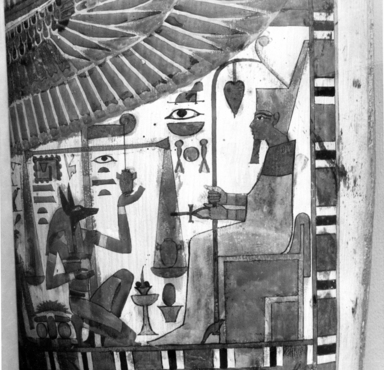
Egyptian. Inner Cartonnage of Gautseshenu, ca. 700–650 B.C.E. Linen, plaster, pigment, human remains, 65 1/4 x 16 1/2 x 11 1/2 in. (165.7 x 41.9 x 29.2 cm). Brooklyn Museum, Charles Edwin Wilbour Fund, 34.1223. Creative Commons-BY (Photo: Brooklyn Museum, CUR.34.1223_neg_L627_29_bw.jpg)
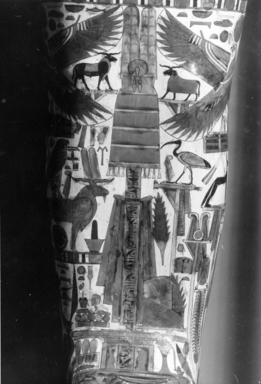
Egyptian. Inner Cartonnage of Gautseshenu, ca. 700–650 B.C.E. Linen, plaster, pigment, human remains, 65 1/4 x 16 1/2 x 11 1/2 in. (165.7 x 41.9 x 29.2 cm). Brooklyn Museum, Charles Edwin Wilbour Fund, 34.1223. Creative Commons-BY (Photo: Brooklyn Museum, CUR.34.1223_negL_348_2_bw.jpg)

Egyptian. Inner Cartonnage of Gautseshenu, ca. 700–650 B.C.E. Linen, plaster, pigment, human remains, 65 1/4 x 16 1/2 x 11 1/2 in. (165.7 x 41.9 x 29.2 cm). Brooklyn Museum, Charles Edwin Wilbour Fund, 34.1223. Creative Commons-BY (Photo: Brooklyn Museum, CUR.34.1223_negL_348_4_bw.jpg)

Egyptian. Inner Cartonnage of Gautseshenu, ca. 700–650 B.C.E. Linen, plaster, pigment, human remains, 65 1/4 x 16 1/2 x 11 1/2 in. (165.7 x 41.9 x 29.2 cm). Brooklyn Museum, Charles Edwin Wilbour Fund, 34.1223. Creative Commons-BY (Photo: Brooklyn Museum, CUR.34.1223_negL_627_31_bw.jpg)

Egyptian. Inner Cartonnage of Gautseshenu, ca. 700–650 B.C.E. Linen, plaster, pigment, human remains, 65 1/4 x 16 1/2 x 11 1/2 in. (165.7 x 41.9 x 29.2 cm). Brooklyn Museum, Charles Edwin Wilbour Fund, 34.1223. Creative Commons-BY (Photo: Brooklyn Museum, CUR.34.1223_negL_627_32_bw.jpg)

Egyptian. Inner Cartonnage of Gautseshenu, ca. 700–650 B.C.E. Linen, plaster, pigment, human remains, 65 1/4 x 16 1/2 x 11 1/2 in. (165.7 x 41.9 x 29.2 cm). Brooklyn Museum, Charles Edwin Wilbour Fund, 34.1223. Creative Commons-BY (Photo: Brooklyn Museum, CUR.34.1223_right_profile_negB_bw.jpg)

Egyptian. Inner Cartonnage of Gautseshenu, ca. 700–650 B.C.E. Linen, plaster, pigment, human remains, 65 1/4 x 16 1/2 x 11 1/2 in. (165.7 x 41.9 x 29.2 cm). Brooklyn Museum, Charles Edwin Wilbour Fund, 34.1223. Creative Commons-BY (Photo: Brooklyn Museum, 34.1223_L348_frame2.jpg)

Egyptian. Inner Cartonnage of Gautseshenu, ca. 700–650 B.C.E. Linen, plaster, pigment, human remains, 65 1/4 x 16 1/2 x 11 1/2 in. (165.7 x 41.9 x 29.2 cm). Brooklyn Museum, Charles Edwin Wilbour Fund, 34.1223. Creative Commons-BY (Photo: Brooklyn Museum, 34.1223_L348_frame4.jpg)

Egyptian. Inner Cartonnage of Gautseshenu, ca. 700–650 B.C.E. Linen, plaster, pigment, human remains, 65 1/4 x 16 1/2 x 11 1/2 in. (165.7 x 41.9 x 29.2 cm). Brooklyn Museum, Charles Edwin Wilbour Fund, 34.1223. Creative Commons-BY (Photo: Brooklyn Museum, 34.1223_L627_frame29.jpg)

Egyptian. Inner Cartonnage of Gautseshenu, ca. 700–650 B.C.E. Linen, plaster, pigment, human remains, 65 1/4 x 16 1/2 x 11 1/2 in. (165.7 x 41.9 x 29.2 cm). Brooklyn Museum, Charles Edwin Wilbour Fund, 34.1223. Creative Commons-BY (Photo: Brooklyn Museum, 34.1223_L627_frame31.jpg)

Egyptian. Inner Cartonnage of Gautseshenu, ca. 700–650 B.C.E. Linen, plaster, pigment, human remains, 65 1/4 x 16 1/2 x 11 1/2 in. (165.7 x 41.9 x 29.2 cm). Brooklyn Museum, Charles Edwin Wilbour Fund, 34.1223. Creative Commons-BY (Photo: Brooklyn Museum, 34.1223_L627_frame32.jpg)
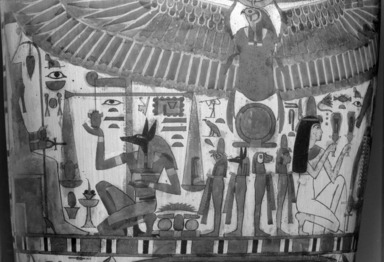
Egyptian. Inner Cartonnage of Gautseshenu, ca. 700–650 B.C.E. Linen, plaster, pigment, human remains, 65 1/4 x 16 1/2 x 11 1/2 in. (165.7 x 41.9 x 29.2 cm). Brooklyn Museum, Charles Edwin Wilbour Fund, 34.1223. Creative Commons-BY (Photo: Brooklyn Museum, 34.1223_L6427_frame30.jpg)

Egyptian. Inner Cartonnage of Gautseshenu, ca. 700–650 B.C.E. Linen, plaster, pigment, human remains, 65 1/4 x 16 1/2 x 11 1/2 in. (165.7 x 41.9 x 29.2 cm). Brooklyn Museum, Charles Edwin Wilbour Fund, 34.1223. Creative Commons-BY (Photo: Brooklyn Museum, 34.1223_NegA_bw.jpg)

Egyptian. Inner Cartonnage of Gautseshenu, ca. 700–650 B.C.E. Linen, plaster, pigment, human remains, 65 1/4 x 16 1/2 x 11 1/2 in. (165.7 x 41.9 x 29.2 cm). Brooklyn Museum, Charles Edwin Wilbour Fund, 34.1223. Creative Commons-BY (Photo: Brooklyn Museum, 34.1223_detail_PS2.jpg)

Egyptian. Inner Cartonnage of Gautseshenu, ca. 700–650 B.C.E. Linen, plaster, pigment, human remains, 65 1/4 x 16 1/2 x 11 1/2 in. (165.7 x 41.9 x 29.2 cm). Brooklyn Museum, Charles Edwin Wilbour Fund, 34.1223. Creative Commons-BY (Photo: Brooklyn Museum, CUR.34.1223_mummychamber.jpg)

Egyptian. Inner Cartonnage of Gautseshenu, ca. 700–650 B.C.E. Linen, plaster, pigment, human remains, 65 1/4 x 16 1/2 x 11 1/2 in. (165.7 x 41.9 x 29.2 cm). Brooklyn Museum, Charles Edwin Wilbour Fund, 34.1223. Creative Commons-BY (Photo: Brooklyn Museum, CUR.34.1223_view09.jpg)

Egyptian. Inner Cartonnage of Gautseshenu, ca. 700–650 B.C.E. Linen, plaster, pigment, human remains, 65 1/4 x 16 1/2 x 11 1/2 in. (165.7 x 41.9 x 29.2 cm). Brooklyn Museum, Charles Edwin Wilbour Fund, 34.1223. Creative Commons-BY (Photo: Brooklyn Museum, CUR.34.1223_view08.jpg)
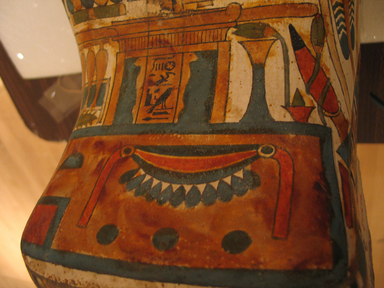
Egyptian. Inner Cartonnage of Gautseshenu, ca. 700–650 B.C.E. Linen, plaster, pigment, human remains, 65 1/4 x 16 1/2 x 11 1/2 in. (165.7 x 41.9 x 29.2 cm). Brooklyn Museum, Charles Edwin Wilbour Fund, 34.1223. Creative Commons-BY (Photo: Brooklyn Museum, CUR.34.1223_view07.jpg)

Egyptian. Inner Cartonnage of Gautseshenu, ca. 700–650 B.C.E. Linen, plaster, pigment, human remains, 65 1/4 x 16 1/2 x 11 1/2 in. (165.7 x 41.9 x 29.2 cm). Brooklyn Museum, Charles Edwin Wilbour Fund, 34.1223. Creative Commons-BY (Photo: Brooklyn Museum, CUR.34.1223_view06.jpg)

Egyptian. Inner Cartonnage of Gautseshenu, ca. 700–650 B.C.E. Linen, plaster, pigment, human remains, 65 1/4 x 16 1/2 x 11 1/2 in. (165.7 x 41.9 x 29.2 cm). Brooklyn Museum, Charles Edwin Wilbour Fund, 34.1223. Creative Commons-BY (Photo: Brooklyn Museum, CUR.34.1223_view05.jpg)

Egyptian. Inner Cartonnage of Gautseshenu, ca. 700–650 B.C.E. Linen, plaster, pigment, human remains, 65 1/4 x 16 1/2 x 11 1/2 in. (165.7 x 41.9 x 29.2 cm). Brooklyn Museum, Charles Edwin Wilbour Fund, 34.1223. Creative Commons-BY (Photo: Brooklyn Museum, CUR.34.1223_view04.jpg)
Inner Cartonnage of Gautseshenu
Egyptian, Classical, Ancient Near Eastern Art
On View: Funerary Gallery 2, Martha A. and Robert S. Rubin Gallery, 3rd Floor
This mummy’s name, Gautseshenu, means “bouquet of lotuses.” The Egyptian word seshen (“lotus”) is the origin of the name Susan.

